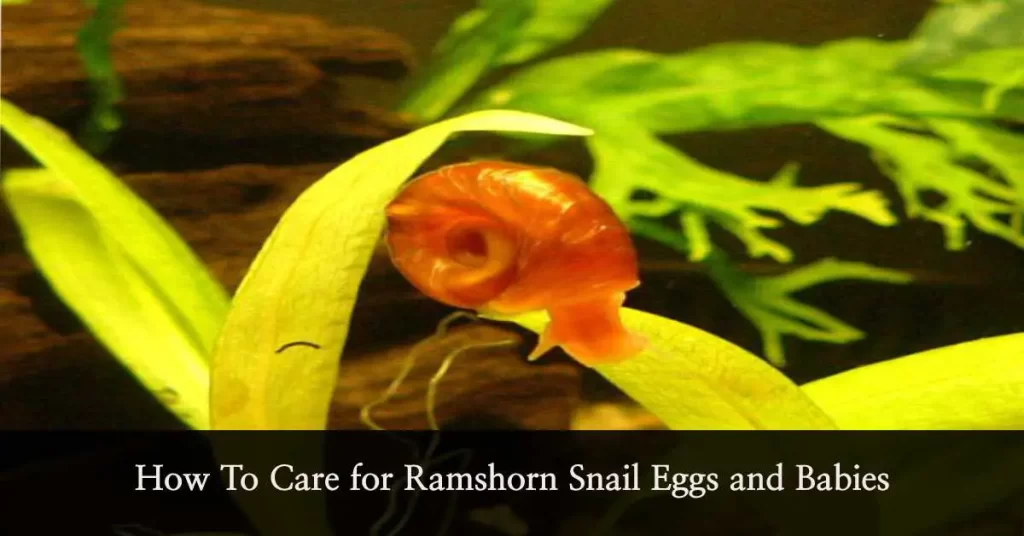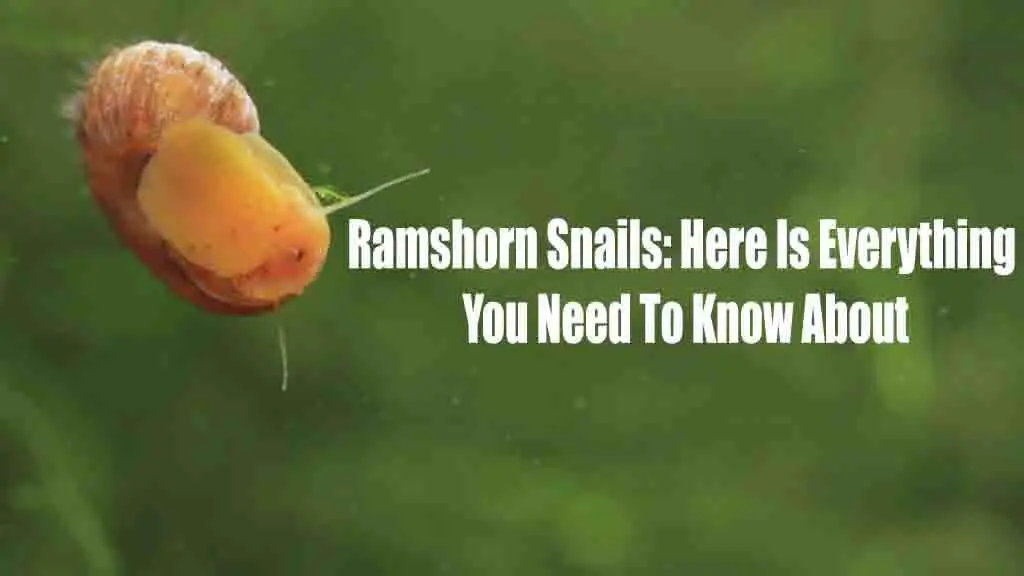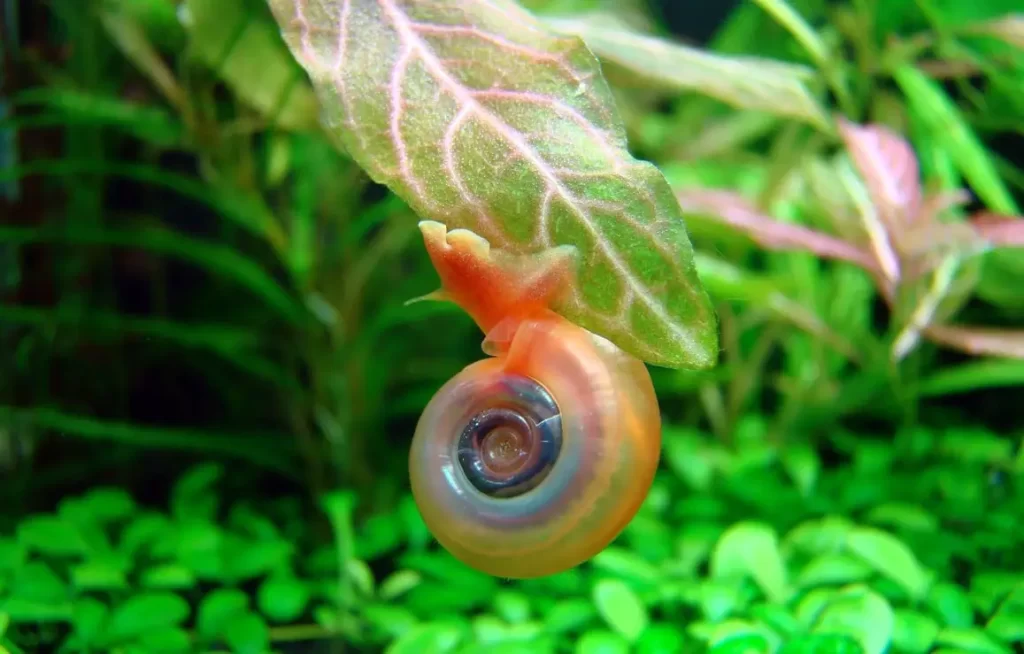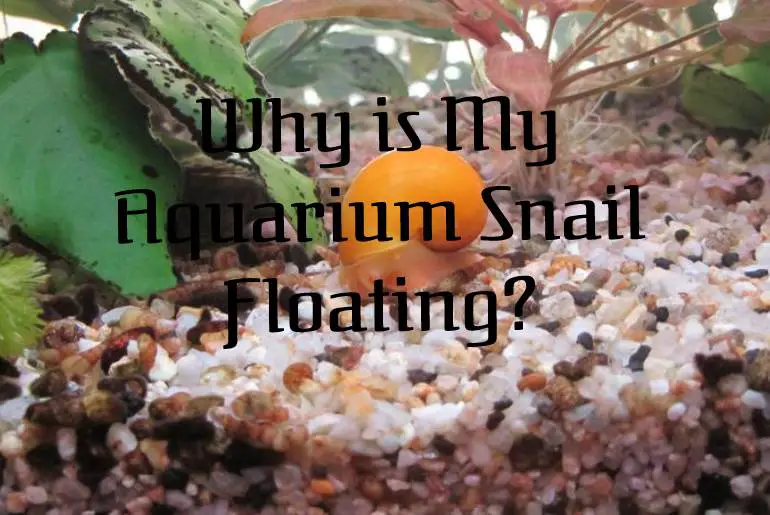No doubt that people have a variety of options in choosing their aquarium species. One of the unexpected but good species for the tank is the Ramshorn Snail. The care for Ramshorn snail eggs and the babies are quite easy. You only need to retain some of the variables such as ecosystem, tank size, growth rate, reproductive rate, life span, water parameters, and eating habits.
Either the Ramshorn Snail Eggs develops randomly by hitchhiking through live plants, accessories, etc. or the tank owners could also breed them intentionally. They are not difficult to breed. Instead, it will be hard in stopping them from breeding. Ramshorn Snails are lovely, fascinating and come in many colors, brown, red, spotted, and a beautiful light blue.
You are bound to see the Ramshorn Snail in your tank, whether you want them as a pet or they are just random pests. This species of snail has a means of cleaning a tank by eating anything that the aquatic animal there has refused. You will find the usefulness of Ramshorn Snail in your tank in many ways. Keep reading the article to find out more about it.
About Ramshorn Snail
Ramshorn Snail is a bunch of small, worldwide freshwater snails. The aquarium shops regularly see them, and fish keepers love them and revile them. The word Ramshorn snail in the aquarium trades includes two families of snails, and while the majority belong to the Planorbidae family, there are some of the Ampullariidae.
Since they have a highly common feature, most aquariums can easily identify themselves as ‘Ramshorn Snails’ under the broad name.
Surprisingly, it is tricky to gather Ramshorn snails in the wild. Some of them live in rivers and small swamps. However, the availability from the aquarium trade is the most noticeable.
In comparison to many other snails, Ramshorn Snails do not breathe through gills. They have an organ known as the snail’s lung that allows them to catch oxygen and to breathe underwater. They also go up to the aquarium floor, or just float to refill their air supply, since they need oxygen.
Related article: Ramshorn Snail Care, Size, Lifespan, Advantages, And Controlling Their Breeding
The appearance of Ramshorn Snail
The appearance of Ramshorn Snails is very varied. It is quite complex! The shell, as well as the skin of the snail, may vary, opening up a world of color mixes.
Colors
You can find in many colors of Ramshorn Snail, with glossy, transparent colors to red, brown, and almost black. In the aquarium trade, red-shelled Ramshorn Snail were once very common, but they appear to have been largely replaced in recent years with brown-shelled snails.
The snail’s skin can typically be black or red. Although the red ones do not, the black snails have melanin pigment. The explanation for the vivid color of red snails is because of their blood. The Ramshorn Snail has blood containing red hemoglobin, as opposed to other snail species.
Shells
About the shells, the names of Ramshorn Snail comes from the look of their exterior shell. It fits perfectly with the flat spiral. It resembles a spiral rope or a horn of the ram. The colors of the shell can differ greatly. The most common hues are light or dark brown shades. More colorful specimens also may have blue, red, and even spotted shells.
The best thing about Ramshorn Snails shell is that they grow larger as it develops. The shells are lightweight and almost translucent as young babies. As the snails grow, the shells can become harder and more opaque with a healthy diet.
Size and Lifespan of Ramshorn Snail
There are various types of Ramshorn snails. They have translucent shells at their tender age and are about 0.25 inches long. However, the covers become less translucent as the snail starts to grow older. Therefore, one way to detect Ramshorn Snail’s age is to take into account their shell. Besides, as the snail gets larger, you should expect their shells to expand width. The average size of the Ramshorn Snail is approximately one inch in diameter.
The total lifetime of Ramshorn Snail is normally only roughly about one year. They could live longer. Many experienced aquariums saw these snails survive with optimum water conditions for approximately three years. These snails can be resilient but require stability of life and plenty of access to high-quality food. By addressing their particular needs explicitly, you will increase their life expectancy substantially.
Ramshorn Snail Care
It really is too easy to bear for Ramshorn Snail, the eggs as well as the babies. Generally, you will not face any trouble even when you have them. The Ramshorn Snail, whether eggs, babies, or adults, are extremely adaptable and can flourish in most environments.
Nevertheless, you cannot afford to degrade the quality when it comes to the water parameters, quality, and the aquarium environment. You must dedicate yourself and be vigilant about protecting their habitats if you want the snails to grow up and remain safe.
Read further to know the specifications.
Tank Size
Ramshorn snails can comfortably house fish in almost any size aquarium. As almost nobody has ever set up a tank specifically for these snails. The good thing about the Ramshorn is you do not need to go and purchase large tanks. Though, if you intend on multiple snails, I suggest you start with a 10-gallon tank. These snails tend to wander around the aquarium despite their slow and steady nature. More space makes it much easier to eat, which is a huge bonus.
Related article: Concept of aquarium size and weight
Water Parameters
Every aquarium should have stable water parameters. By definition, the stable water parameters should include all chemical, biological, and physical factors. The parameters include pH level, temperature, dissolved oxygen, hardness, etc.
For Ramshorn freshwater snails, healthy water conditions are important in two separate ways. First, it will affect the health of your snail. The second is that its shells will develop larger and heavier (which is very important). They do well both in clear and muddy waters.
Related article: Why does my tank get dirty so fast? How to clean and maintain tanks?
Water Temperature:
The temperature range that will help in the betterment of Ramshorn lies in the range of 70°F to 78°F.
The pH Levels:
Another important factor that you must stabilize is the pH level. For the Ramshorn snail, the pH level should be from 7.0 to 7.5.
Water Hardness
The hardness of the water should be from 5 to 15 dKH.
Related article: How to maintain the hardness of the water in the aquarium?
Ammonia and Nitrite Level
The level of ammonia and nitrate should always be 0 in almost every case.
Filter
Standard filtration is sufficient for equipment. It should fit well for a conventional canister or HOB. You are in good shape as long as the filter is strong enough to maintain low nitrate levels.
The lifecycle of Ramshorn Snail
What you should know about the Ramshorn Snail is that they will almost continuously breed if adequate food is available. These snails are hermaphrodites, meaning that two separate snails will fill an aquarium easily. Eggs of Ramshorn Snail do not break and develop into babies. The cluster of eggs will mostly seem hollow or jumbled.
Related article: Ramshorn Snail breeding guide- Full life cycle
Ramshorn Snail Eggs
The Ramshorn Snail lays its eggs wherever possible in your aquarium. This also involves the back of other adult snails. You do not have to worry about caring extra for the eggs. Mainly because the eggs are coated in a strong, protective, jelly-like material, they are typically placed below the waterline by the fertilized parent. They typically hatch around 12 to 40 days, depending on the temperature and conditions of the water.
Ramshorn Snail Babies
Once the Ramshorn snail eggs hatch, you will not discover the babies soon. The Ramshorn Snail babies are quite small.
Even if you want to care and handle them, it would be rather difficult. I want to remind you that not all the Ramshorn Snail Eggs will make it as babies. Do not worry; you did not do anything wrong as these things tend to happen and are a natural process.
It is necessary to find out if the snail eggs made it as babies by smelling them after they hatch. You would know that if there were a bad smell coming out of their body. Make sure you clean the dead snails before it makes your tank toxic.
Quickly afterward, the Ramshorn Snail babies vanish into rock and gravel. You will not see them for quite a while. The babies will pop back up when they are older. So, how do you care for them? Well, you do not have to do anything major. At night, much like the adult Ramshorn Snail, the babies will emerge and feed on detritus.
The digestive system of Ramshorn Snail as babies or adults are relatively weak and underdeveloped. Consequently, much of what they eat exists quickly. The more Ramshorn Snail eats, the more they reproduce. Overfeeding is one of the key reasons for the rapid growth of these snails.
Feeding Your Ramshorn Snail
Diet is one of the key elements you should focus on to care for the Ramshorn snail as eggs or babies. These snails spend a great deal of time looking for food on the hard surfaces of a tank.
Snail food sources included insects, soft algae, unfed fish, and fallen tank mates. Future sources include dead or rotting vegetables. Fish flakes, pellets, low-food feeder capsules, algae wafers, and calcium-rich supplements will also serve as food for Ramshorn Snail.
For healthy shell development, calcium is essential. Hence, to optimize the care for your Ramshorn Snail, and to increase their growth rate, a calcium-rich diet should be prepared.
Fresh vegetables are an often-ignored source of Ramshorn Snail food. Healthy options are rinsed green lettuce leaves, spinach leaves, and even green zucchini pieces.
Another curious approach to these snails is that they sometimes feed into groups. It is just a matter of time for one snail when they find a good source of food, to come out of the woodwork, and share a meal.
The Ramshorn snails can consume live plants well. They can only do so, though, if they do not get enough food elsewhere. They leave the plants alone if you give your snails a healthy diet.
These are also the ingredients to feed the babies when they are large enough to eat. You need not think about feeding the baby Ramshorn Snails, since they find soft algae themselves. Feed-in small quantities so that they can consume in no more than five minutes.
Possible Diseases of Ramshorn Snail
The diseases also occur where there are living organisms. In the case of Ramshorn Snail, it is not about the illnesses they will suffer, but about the diseases, they are going to bring into your tank.
You do not have to focus and care about the Ramshorn Snail for disease; rather the snails introducing diseases to others in the tank. Especially in a community tank.
They could have parasite skin flukes when you purchase them from the supermarket. For these parasites, snails are the ideal host. To complicate things even worst, these are hard to see, so you do not even know you are risking other fish until it is too late.
To add, flukes could lay on other fish’s sides to feast. This leads to stress and other serious health problems.
I recommend placing them in a quarantine tank for about one month if you have new Ramshorn snails. This is just to ensure that you do not jeopardize the larger fish population.
One important note so that you could take care of your Ramshorn Snail babies or eggs and other species is to avoid adding medicine that has copper. Copper and snails do not get along with your Ramshorn and will possibly contribute to their death.
Tank Mates for Ramshorn Snails
Ramshorn Snails do not bother even the smallest species. It makes them perfect clean-up agents in fry aquariums, where young species sometimes waste most of the food they have. However, the one thing that you should keep attention to is other species that might harm the snails. The Ramshorn Snail eggs, babies, and adults will need care and protection from few species.
Good Tank Mates:
- Livebearers
- Tetras
- Gourami
- Danios
Related article: Longfin Leopard Danios Care Guide
- Small Shrimp
- Rasboras
Related article: Galaxy Rasbora care guide
Bad Tank Mates:
- Crayfish
- Goldfish and Barbs
- Pufferfish
- Loaches
Related article: Kuhli Loach Care Guide
- Cichlids
Related article: Red Devil Cichlid care guide
Conclusion
From reading the article, you may have got some insight to care for the eggs and babies Ramshorn Snail. Once you understand the nature of the snail, you will find it very easy to care.
Moreover, the point is that the Ramshorn snails can look after themselves. All you will need to do is maintain balance in the water parameters, environmental conditions, and quality. They are unusual but interesting species to add to your tank.






